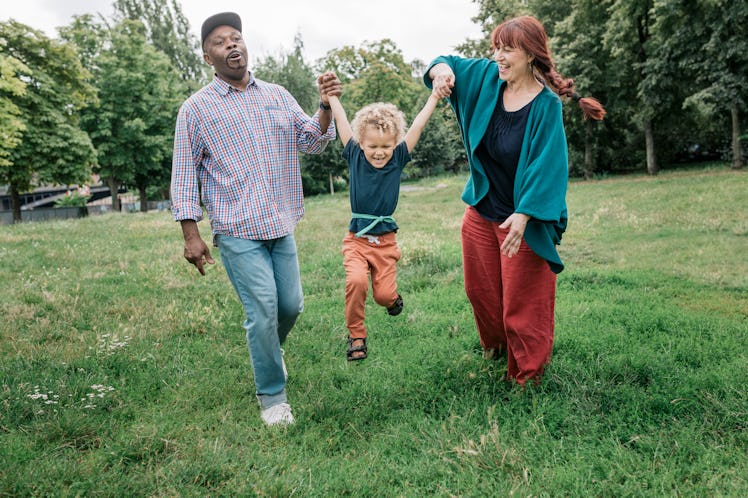How To Fix Nursemaid’s Elbow, According To A Surgeon
Nursemaid's elbow is nothing to freak out about. Here's what parents need to know.

Swinging their kids by their wrists for fun or pulling them out of the street for their safety is a normal occurrence in parenthood. However, having their arm go limp suddenly is extremely alarming. Rest assured that it’s incredibly common in children, and it’s not even a fully dislocated elbow, even if it very much resembles one. It’s nursemaid’s elbow, otherwise known as a pulled elbow or radial head subluxation.
Nursemaid’s elbow is not typically painful, has no known long-term consequences, and mostly just scares the hell out of moms and dads. The only issue is that children cannot usually use that arm until someone pops it back into place, says Jennifer Weiss, M.D., of the American Academy of Orthopedic Surgeons. Here, she shares what parents need to know about how to fix nursemaid’s elbow — and how to avoid it in the first place.
How To Fix Nursemaid’s Elbow
Nursemaid’s elbow is not the same thing as a dislocated elbow, although it’s close. Rather, it occurs when the bone, called the radius, begins to dislocate from the elbow joint, but stops short.
“There’s a joint in the elbow, made up of three little bones, and one of the bones is called the radius,” Weiss says. “The radius subluxes, or moves around the joint, but it doesn’t dislocate or come out.”
It’s usually an adult’s fault. Parents swinging or yanking their kids by the wrist seldom realize that the relatively benign, parental gesture can sublux a radius like nothing else. “A kid gets pulled, most commonly because a parent is trying to have fun,” Weiss says. “A parent pulls the child by the wrist or picks them up and throws them around, and then the radius can sublux in the joint.”
You’d think parents yanking their kids’ radiuses out of line would be a relatively rare phenomenon, but it’ (probably) not. “We don’t have a good sense in a scientific, epidemiological way — we don’t have a study that says it happens to X percent of kids,” Weiss says. “But it’s common. Most people have heard of it, and almost every parent has seen somebody with it.”
Fixing nursemaid’s elbow is pretty simple, and safe to do at home as long as you’re certain that there’s no fracture (if there is a fracture, this procedure can make things worse).
“There’s a maneuver, where the elbow is bent with the wrist pulling toward the shoulder,” Weiss says. “When you do that, sometimes you’ll hear a pop or a click.” Although it won’t always result in pain relief immediately, that’s usually all it takes. “I will have the child wait in the waiting room after the maneuver,” Weiss says. “Almost always, about 45 minutes later, the child is happy.”
One of the odd quirks of nursemaid’s elbow is that it is almost never detectable by X-ray or MRI, which means diagnosing the condition has a lot to do with a physician’s intuition and experience. “It’s really a clinical diagnosis,” Weiss says. “In my mind, I want to be sure I’m not missing a break or an infection. So if I know the child has been pulled by [their] wrist, I do the maneuver and give it some time. If it truly doesn’t help, then I move on to X-rays. An infection is far less likely than a break, and that’s something we’d then diagnose by taking labs.”
Despite rumors to the contrary, there’s no evidence that nursemaid’s elbow leads to arthritis or elbow instability, according to Weiss. But just because there’s no long-term damage doesn’t mean a painful injury isn’t worth learning how to avoid.
“Do not lift your children by their wrists, and don’t twirl them by the wrist,” Weiss says. As for you and your partner holding your child’s hands and swinging him in the air, Weiss has similarly sober advice: “Don’t do that.”
But Weiss also stresses that, given all of the terrifying parts of parenthood, nursemaid’s elbow is probably not the sort of thing that should keep you up at night.
“I’m always worried if a child is in pain, but we have to choose what we’re going to be anxious about as parents,” Weiss says. “This is not the one I’d be nervous about.”
Your Nursemaid’s Elbow Cheat Sheet
- Seek a clinical diagnosis from a physician before trying anything at home to ensure there isn’t a break or infection, especially if your child has a lot of pain.
- Bend the below with the wrist pulling toward the shoulder. Wait for a pop or a click.
- Avoid lifting your children by their wrists, and don’t twirl them by the wrist. Similarly, don’t hold your child’s hands and swing them in the air.
This article was originally published on